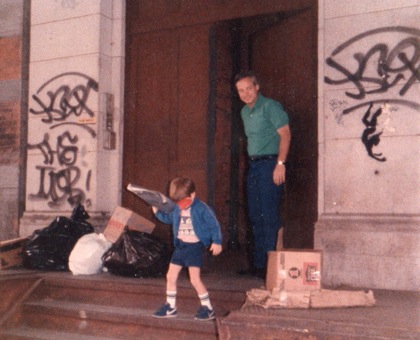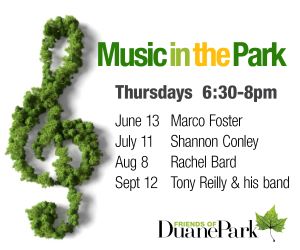Did That Really Happen?

 About the author: Gardiner Comfort is an actor and teacher who grew up in a loft in Tribeca [above]. He graduated from Brooklyn Friends School, Skidmore College, and then the American Repertory Theater’s Acting Institute at Harvard. He curates a monthly night of new work at the Parkside Lounge on the Lower East Side and finds himself performing in Shakespeare plays more than anything other type. He lives with his wife in Harlem.
About the author: Gardiner Comfort is an actor and teacher who grew up in a loft in Tribeca [above]. He graduated from Brooklyn Friends School, Skidmore College, and then the American Repertory Theater’s Acting Institute at Harvard. He curates a monthly night of new work at the Parkside Lounge on the Lower East Side and finds himself performing in Shakespeare plays more than anything other type. He lives with his wife in Harlem.
When I’m walking through New York, I spend a lot of time going out of my way to notice little details on buildings and in streets. Sometimes I’ll stand and stare at a wrought-iron fixture in a brick wall and try to understand what it’s for. Or I’ll find myself marveling at manhole covers or the way a sidewalk crumbles into the street. I especially like finding elements of old New York that are still lying around, rusting away amid all the progress, something the improvement somehow missed. I look at all these things with a longing and a sense that I’m recording them, because I know they will be short lived. They too will undergo renovation.
I’m a serious nostalgist, and I have trouble letting go of times gone by. I guess that growing up in a neighborhood like Tribeca makes it all the harder. Even when I was born in 1980, the neighborhood was already in flux. Strictly industrial for a very long time, it saw its first residential boom not long before I came onto the scene. Of course, it would be a long time before residents outnumbered industrial spaces but it was quickly becoming a haven for artists, and many residents had young children. And we thought it was all normal: to operate aging freight elevators up to our homes while our parents watched on, or to find petrified lentils in our floors, reminders of the area’s food-storage days. It wouldn’t be long before Tribeca would develop a cachet and sense of mystique for adventurers from north of 14th Street. But no one knew then just how popular and “improved” a neighborhood it would become. The changes are so vast and ever-increasing that it seems all the more important to revel in the memories of the days of yore. The mystique of a desolate industrial landscape seems so out of place with so many people around, crowding into sleek restaurants and high-end stores.
One of the times when I knew everything had gone haywire was maybe 10 years ago, when a truck was loading something into a building on N. Moore. It was using the traditional method of backing directly into the loading dock and jutting out perpendicularly to the street, so that any traffic would have to drive around it—causing chaos and anger in the livery cab and SUV drivers. In the ‘80’s, kids in Tribeca would duck under those trucks to avoid the long trip around them. I recently relayed stories of checking with my mother before doing so to a new Tribeca resident who brusquely expressed that it sounded dangerous.
Another memory of old Tribeca is that of beat-up stairways. Just about every friend I had as a kid lived in a loft building and most of the stairs looked more or less like they had for decades: dimly lit, atrophied, with a long ascent from the street level door straight to the third or fourth floor, an exhausting climb with the occasional break at each floor’s landing. There was always a good deal of artsy decoration at each tenant’s door but my favorite was the treasure my friend Orien lugged up from the street: a four-foot-tall, foot-operated industrial stapler that we would stamp upon entry. Such a find would be unheard of now.
But Tribeca, like all of downtown Manhattan, was once a treasure trove of found objects. I remember getting tons of use out of those massive cardboard fabric tubes that were always lying around, skateboard jousting being a favorite activity. One winter, when people had resorted to standing discarded Christmas trees up in the snow drifts, my mom and I found mannequins on Franklin Street and upped the ante by propping them up as well, as if they were at some surreal, naked Christmas party.
At a certain point in the 90s, at least half of the block surrounding my parents’ house was vacant warehouses, and my friends and I learned that we could access them from our roof. We creeped through spooky, dark spaces and stepped over holes in the floor. I somehow believed that the defunct water tower and shattered skylight were ancient artifacts that shouldn’t be tampered with. I was a kid, and I didn’t believe in change.
In many ways I still don’t. I sometimes laugh at myself for being so stubborn about inevitable changes in this ever-evolving city. The past will never return, no matter what I do. And I imagine people like me hold themselves back with our refusal to accept the reality of change. It could be argued that there is a use for modern street lamps and paved streets. But I know that at least a part of my nostalgia is worthwhile, that there must be something to my constant and desperate recording and remembering, my assuring myself that the past really happened. One day I was in a diner at Chambers and Church and I saw a man I hadn’t seen in the neighborhood for years. He had worked at the hot dog vendor depot in the ground floor space of my old friend Stefan’s loft building, where the proprietor with the Salvador Dalí mustache would sit out front greeting people. Oddly enough, though it’s prime real estate, the space still houses the hot dog garage. I watched the man as he sat at the counter, staring at the exposed kitchen. I might be reading too far into it but he seemed so unfazed by all of the changes around him, comfortable in his place in the world. I wanted to share the moment with someone, to make it live on in some permanent way. But looking around, I saw only strangers. I could only transmit the image to a safe place in my mind, the only spot where the past can truly live.
















Thank you for this wonderful piece. I can remember the days of the old Washington Market before the move to Hunts Point which made room for the artists. The trucks were unloaded by casual workers often from the Bowery and known as rummies because they worked long enough to afford one of those flat bottled cheap boozes. They would fall asleep right on the loading docks under the protection of the overhangs. Those were tough times and this was a tough neighborhood.
What a lovely remembrance. I still live on Franklin Street, the sole tenant of an abandoned building that was once a cheese factory then Alexander Calder’s studio. I’ve been here since 1984. What I miss the most is stoop sitting. On any given lonely night, I could get a bottle and a couple glasses, sit on my stoop, and friends would stop by and sit for a drink. Now I could sit on a Tribeca stoop all night and no one would stop to share a shot. That, and this year my landlord demolished our stoop.
Wonderful to read your piece, I enjoyed and related to every inch of it.
Lovely piece. Wanted it to just keep going. I never lived in Tribeca, but I have fond memories of everybody taking their beers out to sit on the stoop at Mickey’s and gaze out across the Hudson–there was nothing between the west side of Greenwich Street and the river. And the Movies on the Beach, the beach being the landfill that would be the future site of Suyvesant High. And people’s collections of stuff they found on the street–one friend had accumulated hundreds and hundreds of shoe lasts, for example.
Yeah, then the children come along with their parents’ desire for safe & clean buildings, stairwells, sidewalks, intersections, neighborhoods & schools and it just ruins the fabric of those once tight-knitted, fun communities. They ruin everything. Wish we could turn back the clock.
Thanks for the lovely comments everyone. And Luc Sante! Amazing. I am a HUGE fan of Lowlife. Unbelievable. And my wife is in Hermanautic Circle. Not sure if I’m supposed to be getting so personal on the comments page but I guess the fame is going to my head! Thanks Eric, for posting my piece. I hope to write more. Long live Tribeca!
Having grown up in Tribeca at exactly the same time as you, I am A.) amazed I don’t know you and B.) I share your nostalgia for legitimately used loading docks, freight elevators and sideways-leaning staircases lit with green lightbulbs.
Gardiner, Thank you for this! I grew up in Tribeca too (born in 1985) and miss the days where I learned to ride my bike down an empty Greenwich Street, or was forced to endure my mother buying “Fruit Leather” at Commodities on N. Moore as a replacement for my beloved Fruit Roll-Ups.
I desperately miss the community and diversity of those days. Sometimes I like to walk up Washington Street and remind myself of what it was like when all the streets in Tribeca were cracked, all the buildings looked worn.
For many years, I lived in cities and towns in Italy, France, England, Spain California and Hawaii and I know what you know: Tribeca in the 80s was perhaps the most colorful place of all. Its scruffy, offbeat charm made me feel ever so privileged. I thought our daughter was so very lucky to grow up with the Riverrun restaurant and Puffy’s Tavern and Nolan Henry’s suprette, Bazzini’s when it was still a peanut butter factory and the Washington Market Park before it was all tarted up (still a great park in its newer incarnation). The Public Theatre used to produce Shakespeare’s plays on makeshift stages in the middle of Greenwich Street, and I wonder if that didn’t launch you and my child into the actor’s life. We still have the Square Diner, Puffy’s, Morgan’s corner grocery and Sue Ellen’s tumbling classes. For those of my generation and your parents’, we have offbeat, adventurous, fascinating children who still like to live here or come home for a long look around. Thanks for a lovely piece.
Loved reading this Gardner, you the kids of TriBeCa have such a unique perspective on a city in flux. How great for you to set some of it down. I am sending this on ot my downtown kids and beyond. Thanks
Great job Gardiner! We’ve been here since ’78 when Tribeca was truly a neighborhood where everyone knew everyone and we all had common interests, truly an artsy environment. Before I moved downtown from the village I used to visit my brother on Duane St. & park in the empty lot which is now Washington Market Park. The Washington Market Montessori School was housed in what is now the Food Emporium. It had huge windows looking out onto the park before the FE bricked it up. We even had a food coop on Harrison or was it Jay St. We cheered when P.S. 234 was built & our kids had a fine environment to learn. They sure did learn there when there were only a few classes & these classes were truly filled with diversity, some children bused in to keep it diverse, so that our children would benefit from that. We worked together at the school to produce floats for the Village Halloween Parade when it meandered through the streets of the Village before the parade got too big & moved to 6th Ave. We moaned when Riverrun left and we’re still moaning when we see what the neighborhood has transgressed into. It was a great experience raising our children here and I think they truly benefitted from growing up in Tribeca as we knew it. We still have our memories of finer days & those will always be with us.
Yup, Tribeca is such a shit hole now. I can’t believe parents remain to raise their children in this environment. Today, nobody knows anyone’s name, even their own children’s, and no one helps anyone else out, not even to hold the door. People lie in the streets bleeding to death. Children go hungry. Goldfish go thirsty. I wish the older & wiser Tribeca residents had stayed to show people how to really live properly & artsy. Maybe they all moved to a “real” real neighborhood. I hope they don’t tell me where.
It’s the small details that make the big tableaux in my memory come to life. Thanks for that. Well done!
Jim Smithers, Do I hear sarcasm? It’s all true . You did miss an exceptional time when Tribeca (god, I still hate that name) was really was a magical place with actual interesting human beings.
@Anna – No, it’s not sarcasm, it’s deep, flesh-penetrating jealousy. I hate having to buy my mannequins, when years ago they were just lying around in bunches on the sidewalks. I remember reading the newspapers back then that would describe the area as one of the top neighborhoods to live and it was “magically magical” and real estate agents would tell you that “not only is it magically magical, but there are also truly interesting people living around here.” I hate the name TriBeCa too, maybe it could be called West Chinatown or Magic-lessTown? Now I have to go run out to get batteries for the TV remote (thank god there is somewhere to buy them these days), I hope I don’t run into any walking zombies (or EriK) pushing their zombie strollers and sipping zombie macchiatos. Just in case, I will bring my magic pepper spray to squirt in the lifeless-eyes of the baby zombies. I do it for you, Anna, I do it for you.
I’m with Jim. It’s outrageous how much Mannequins cost nowadays. But what are you gonna do? It’s not like you just can’t buy them or something. It’s a freakin’ monopoly. As for the zombies go, your pepper spray WILL NOT work, no matter how magically magical it is. If you haven’t been watching The Walking Dead, you must sever or destroy the head. Ugly work, but that’s survival I guess. You get used to it, but damn if it doesn’t harden you in the process. I just wish I could enjoy their undead macchiatos.
@Gardiner – Sever or destroy a baby’s head? Are you mad?!! The parents of PS 234 will surely block any attempt at the rezoning of children’s heads, unless they’re the heads of the zombie children north of Canal or east of Broadway, then whatever happens happens. But thank you for your words, Gardiner, they were very comforting. It’s raining, time to Weather Up!
Smithers is a sarcastic synchophant with a sense of entitlement and profound bigotry.
@Katrina – Suggestion #1 – Buy a dictionary. Suggestion #2 – Use that dictionary. Suggestion #3 – Spell-check your comments, especially the big words. Suggestion #4 – Please provide some context for your insults/compliments, so we can all enjoy your thought process.
Nice piece Gardiner. Beautifully written. Sounds exactly like the stories from Orien and the boys.
Wow. We had our own manniquin for years. I dragged it down Chambers Street, myself and we decorated it with Christmas garland just to update it around the holidays. We move into our Duane Street loft in 1972 and nobody believes I skated down Lower Broadway to the Bowling Green on Sunday mornings because there were absolutely NO cars on the streets then. Our daughter was born in 1983 and she was always lugging telephone electrical “junk” tossed into the street from the various manufacturing buildings. Does anyone remember “Jules” who sold coffee beans down on Lower Duane from his wholesale shop? He loved to argue politics!
Re: Jean’s entry.
Thanks for the comment Jean! I’m continuously enthused that there are so many old timers still around. I just left my parents at the loft arguing about selling. Oy. Your daughter sounds like a typical downtown kid. My friend Orien used to talk about his dad running and lifting him up as he ran his legs along the steel girders of the closed stores at night, making a loud clamor on the desolate streets.
Jules, “Lower Duane”? Not sure but my mom might remember him. I vaguely remember an INCREDIBLY stinky cheese shop on or around west Chambers st. that I hated going into but was drug in by my mom. It’s so funny how many busy stores there seemed to be. You have to remember that it wasn’t just a ghost town. It was a functional neighborhood, just not at night or on the weekends. I actually read a great entry in Joseph Mitchell’s Up in the Old Hotel about an old bar on Greenwhich st. that he used to go to in the 40’s. Amazing.